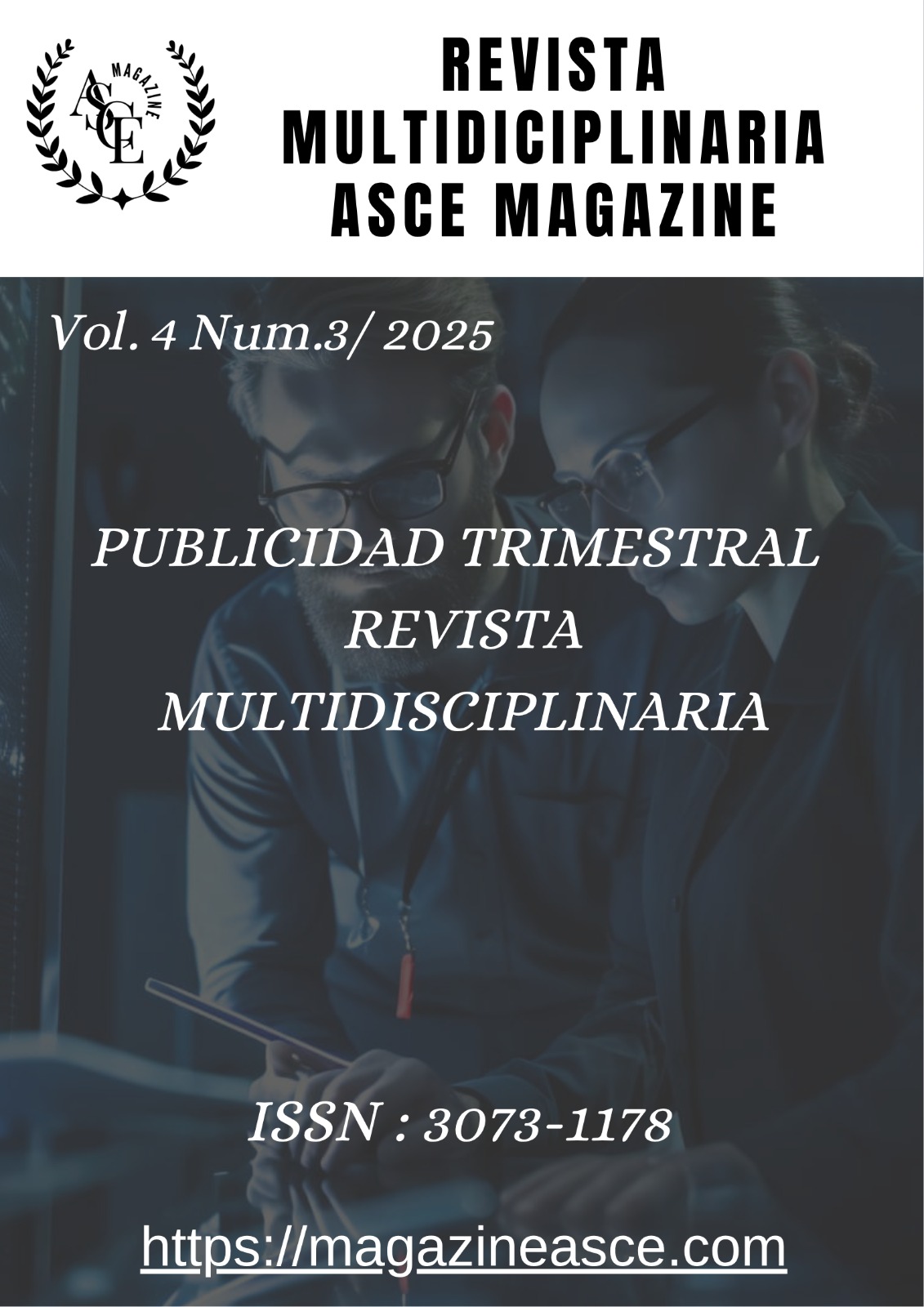Limitaciones del Modelo LSTM en la Predicción de Demanda Eléctrica con Datos Simulados de Bajo Volumen
DOI:
https://doi.org/10.70577/ASCE/240.260/2025Palabras clave:
Demanda Eléctrica, LSTM, ARIMA, Aprendizaje Automático.Resumen
El análisis evaluó el modelo LSTM para predecir la demanda eléctrica, utilizando un conjunto simulado de 1000 puntos (42 días) con variables como temperatura, radiación solar y tipo de consumidor (residencial/industrial). Los resultados muestran un desempeño deficiente, con valores negativos de R² (-0.0043, -0.1380, -0.0849) y RMSE elevados (29.23, 31.68, 30.52), indicando predicciones menos precisas que el promedio de los datos. La configuración del modelo (50 neuronas, look_back=24) resultó inestable, probablemente debido al tamaño limitado del conjunto de datos y a la incapacidad para capturar relaciones entre las variables y la demanda eléctrica. La literatura destaca que los modelos LSTM requieren grandes volúmenes de datos y una optimización cuidadosa para ser efectivos. Comparado con ARIMA, un método estadístico tradicional, el LSTM no logró capturar patrones temporales complejos. Los desafíos incluyen la calidad de los datos, la complejidad del modelo y la integración con sistemas heredados. Se sugiere aumentar el tamaño del conjunto de datos, ajustar la arquitectura del modelo y explorar enfoques híbridos (LSTM+ARIMA) para mejorar la precisión. Este análisis resalta la importancia de alinear la complejidad del modelo con los datos disponibles para optimizar la gestión energética en redes inteligentes.
Descargas
Citas
Al-Haddad, Y., Abdu İbrahim, A., & Naeem, R. (2024). Forecasting energy consumption in smart grids: A comparative analysis of recurrent neural networks. Iraqi Journal for Computers and Informatics, 50(1), 123–132. https://doi.org/10.25195/ijci.v50i1.492 DOI: https://doi.org/10.25195/ijci.v50i1.492
Ali, B. M. (2023). Load predictions in electrical energy network: Current knowledge and future directions using machine learning. 2023 6th International Conference on Engineering Technology and Its Applications (IICETA), 589–595. https://doi.org/10.1109/IICETA57613.2023.10351352 DOI: https://doi.org/10.1109/IICETA57613.2023.10351352
Allal, Z., Noura, H., Salman, O., & Vernier, F. (2024). Predicting power consumption using machine learning techniques. 2024 International Wireless Communications and Mobile Computing (IWCMC), 1522–1527. https://doi.org/10.1109/IWCMC61514.2024.10592560 DOI: https://doi.org/10.1109/IWCMC61514.2024.10592560
Amat Rodrigo, J., & Escobar Ortiz, J. (2023). Skforecast [Computer software]. Zenodo. https://doi.org/10.5281/ZENODO.8382788
Belhaiza, S., & Al-Abdallah, S. (2024). A neural network forecasting approach for the smart grid demand response management problem. Energies, 17(10), 2329. https://doi.org/10.3390/en17102329 DOI: https://doi.org/10.3390/en17102329
Dahya, T. (2023, December 4). Using Machine Learning to predict US electricity demand: A comparison of two approaches. Medium. https://medium.com/@tdahya2/predicting-us-electricity-usage-a-comparison-of-two-approaches-34303b81a4aa
Duan, Y., Xu, Z., Chen, H., & Wang, Y. (2025). Novel machine learning approach for enhanced smart grid power use and price prediction using advanced shark Smell-Tuned flexible support vector machine. Scientific Reports, 15(1), 20909. https://doi.org/10.1038/s41598-025-05083-0 DOI: https://doi.org/10.1038/s41598-025-05083-0
Hussain, I., Ching, K. B., Uttraphan, C., Tay, K. G., & Noor, A. (2025). Evaluating machine learning algorithms for energy consumption prediction in electric vehicles: A comparative study. Scientific Reports, 15(1), 16124. https://doi.org/10.1038/s41598-025-94946-7 DOI: https://doi.org/10.1038/s41598-025-94946-7
Ibrahim, B., Rabelo, L., Gutierrez-Franco, E., & Clavijo-Buritica, N. (2022). Machine learning for short-term load forecasting in smart grids. Multidisciplinary Digital Publishing Institute. https://dspace.mit.edu/handle/1721.1/146313 DOI: https://doi.org/10.3390/en15218079
Jain, A., & Gupta, S. C. (2024). Evaluation of electrical load demand forecasting using various machine learning algorithms. Frontiers in Energy Research, 12, 1408119. https://doi.org/10.3389/fenrg.2024.1408119 DOI: https://doi.org/10.3389/fenrg.2024.1408119
Lee, S. (n.d.). Revolutionizing smart grids with machine learning. Retrieved July 10, 2025, from https://www.numberanalytics.com/blog/machine-learning-in-smart-grids
Machine learning for product demand forecasting—The guide. (n.d.). Slimstock. Retrieved July 10, 2025, from https://www.slimstock.com/blog/machine-learning/
Manav. (2023, December 22). The role of ai and machine learning in power price forecasting. Future Bridge Events | Conferences & Summits. https://future-bridge.eu/the-role-of-ai-and-machine-learning-in-power-price-forecasting/
Philips, A., & Jayakumar, J. (2023). Time-series based household electricity consumption forecasting. 2023 11th International Conference on Smart Grid (icSmartGrid), 1–15. https://doi.org/10.1109/icSmartGrid58556.2023.10170973 DOI: https://doi.org/10.1109/icSmartGrid58556.2023.10170973
Roy, K., Ishmam, A., & Taher, K. A. (2021). Demand forecasting in smart grid using long short-term memory. 2021 International Conference on Automation, Control and Mechatronics for Industry 4.0 (ACMI), 1–5. https://doi.org/10.1109/ACMI53878.2021.9528277 DOI: https://doi.org/10.1109/ACMI53878.2021.9528277
Strielkowski, W., Vlasov, A., Selivanov, K., Muraviev, K., & Shakhnov, V. (2023). Prospects and challenges of the machine learning and data-driven methods for the predictive analysis of power systems: A review. Energies, 16(10), 4025. https://doi.org/10.3390/en16104025 DOI: https://doi.org/10.3390/en16104025
Ugbehe, P. O., Diemuodeke, O. E., & Aikhuele, D. O. (2025). Electricity demand forecasting methodologies and applications: A review. Sustainable Energy Research, 12(1), 19. https://doi.org/10.1186/s40807-025-00149-z DOI: https://doi.org/10.1186/s40807-025-00149-z
Descargas
Publicado
Cómo citar
Número
Sección
Licencia
Derechos de autor 2025 Christian Paul Reyes Orozco, Cristian Luis Inca Balseca

Esta obra está bajo una licencia internacional Creative Commons Atribución-NoComercial-SinDerivadas 4.0.






























